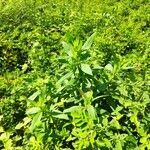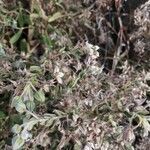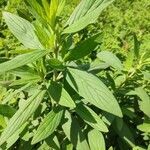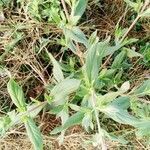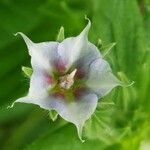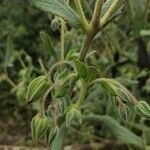Erect, perennial herb with annual stems from a woody rootstock, up to 1.5 m high. Stems, inflorescences and petioles patently hairy. Leaves sessile or petiolate; blade elliptic, 30-110(-120) x 10-30(-35) mm, base rounded to subcordate, apex acute, discolorous, upper surface with long, up to 0.75 mm, larged-based, 2-layered setae and much smaller setae in between, orientated ± in same direction, lower surface with long setae on midrib and major veins only, intercostal area densely covered with small, bulbous-based setae orientated in different directions; petiole up to 10 mm long. Flowers with pedicels up to 30 mm long in fruit. Calyx lobes ovate, ±9 x 3 mm in flower, 15-18 x 7-9 mm in fruit. Corolla very pale blue, darker at edges of lobes, with reddish purple marks at junction of lobes or lobes with white along mid-area, blue in outer areas; tube funnel-shaped, 5-7 mm long; lobes 5 or 6, broadly ovate, ±5 x 1.5 mm, with abrupt, acuminate apices, usually twisted. Fruit of four nutlets; nutlets greyish marble brown, compressed ovoid, ±4.0-4.5 mm long, external face ± convex, shiny, internal face 3-angled, rugose.
Leaves (3)5–12(15) x 1–3(4) cm., narrowly elliptic, cuneate or occasionally rounded at the base, usually acute at the apex, sessile or subsessile, opposite or the uppermost alternate, the upper surface covered with tuberculate setae and sometimes with smaller hairs between them, the lower surface with tuberculate setae on the major veins and usually with a dense covering of smaller spreading or appressed hairs between them.
A soft herb. It keeps growing from year to year. It is usually 50 cm high but can grow to 1 m high. The leaves are large and opposite in pairs up the stem. The leaves are thick and have distinct veins. They taper to the base with little or no stalk. The stem and leaves are hairy. The flowers are pale purple or white. They hang down in groups like small bells. Each flower has 5 petals.
Inflorescence 1–5 cm. long at flowering, elongating to up to 14 cm. in fruit, many-flowered, terminal on main and lateral branches, bracteate for most or all their length, the bracts ovate to lanceolate and rounded or subcordate at the base; pedicels 1–3 cm., densely clothed with conspicuous flexuous spreading hairs up to 2 mm. long and often also with minute spreading hairs.
Fruit comprising four nutlets, falling separately to leave a pyramidal gynobase with four strongly concave sides, each with a more or less winged margin, and a persistent terminal style; nutlets 4–4.5 x 2.5–3.3 x 1–1.5 mm., compressed-ovoid, smooth and shiny and usually mottled with grey and brown on the outer surface, rugose on the inner surface.
Annual with a tap root, or perhaps occasionally a short-lived perennial with a somewhat woody stock, with erect stems 0.3–1.5(2.0) cm. high, with ascending branches in the upper part; stems clothed with short spreading hairs interspersed with coarse tuberculate setae, or occasionally only with the tuberculate setae.
Annual or short lived perennial herb, 0,20-1,75 m high. Pedicels and inflorescence axes densely clothed with flexuous spreading hairs 1-2 mm long. Corolla 7-9 mm long. Nutlets 4, smooth. Flowers with lobes pale blue to lilac or pinkish, tube often whitish between lobes and with red to purple markings at its base.
Sepals 7–10 x 2–3.5 mm. at flowering, enlarging to up to 20 x 6 mm. in fruit, ovate to lanceolate, rounded at the base, acute at the apex, densely clothed with long appressed or ascending hairs with those on the midrib and margins usually tending to be setose and more strongly tuberculate than the others.
Corolla 7–9 mm. long, slightly shorter than to slightly longer than the sepals, the lobes broadly ovate-acuminate; lobes pale blue to lilac or pinkish, the tube often whitish between the lobes and with red to purple markings at its base.
